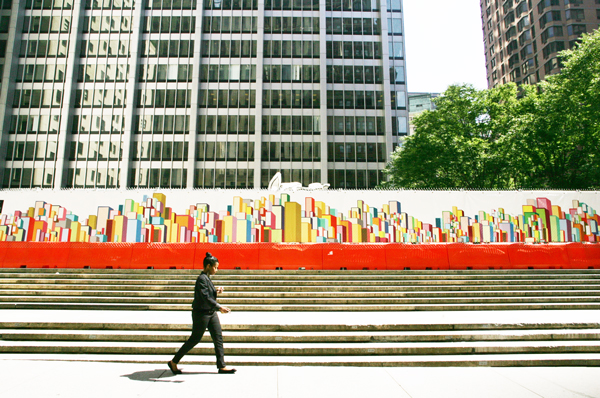
BY ALINE REYNOLDS | Chase Manhattan Plaza will continue to be off limits to the public until the flowers bloom next year, prompting outrage among Financial District residents and workers.
Officials from JPMorgan Chase, who briefed Community Board 1 about the closure at a committee meeting on Thurs., July 19, announced that the 70,000-square-foot plaza in front of the 1961 skyscraper would be undergoing a badly needed overhaul that will require it to be closed until next May.
In the interim, the bank will caulk the plaza’s pavers to rid it of leaks, replace its faulty piping and drains and give the flooring a power wash, according to Bill Viets, a managing director and associate general counsel at the bank. Workers will use vector mapping, a technique used to pinpoint defects in the plaza’s below-grade infrastructure.
JPMorgan Chase, the plaza’s owner, deemed the fixes necessary after a thorough inspection of the plaza.
“The leaks have been coming from multiple sources, not only affecting banking operations in our retail branch but [the] means of egress to and from the subway system and the concourse,” according to John Babieracki, a managing director at the bank.
But area residents present at the C.B. 1 meeting railed against this decision and asked the bank to instead consider blocking off segments of the plaza at a time.
Nassau Street resident David Colman was so angered by the plaza’s inaccessibility that he closed his Chase checking account. Colman, a Financial District resident for 15 years, has fond memories of training his dog in the plaza.
“It’s really tacky and gross,” he said of the closure. “That plaza belongs to the community and the people in it.”
Ro Sheffe, who chairs C.B. 1’s Financial District Committee, pointed out that the plaza has already been closed for more than six months already.
“I appreciate your doing what you can to limit it only to a six-month period,” he said, “but from the perspective of the community, that makes it an 18-month period, almost.”
Rumors have been swirling among Downtown residents and construction workers that the plaza’s closure is attributable to Occupy Wall Street — since, according to reports, the plaza was cordoned off a day after O.W.S. began at the nearby Zuccotti Park.
That’s at least what the wife of 46-year-old Fulton Center construction worker, Ray Candelario, said. She reportedly works at JPMorgan Chase.
“They didn’t want the protesters going in there and interrupting their business,” he said.
Candelario, who misses hanging out at the Chase Plaza, has been taking his lunch breaks at the plaza facing 140 Broadway, instead. “There’s too much traffic, and it’s too open,” he said. “Over there [at Chase Manhattan Plaza], it was kind of enclosed, so there was a little peace and quiet.
“So, I’m caught in the middle, because I like the space, but now I can’t use it just because they don’t want the problems with the protesters.”
Officials, however, denied the claims of a correlation between the plaza’s closure and O.W.S. “It really has nothing to do with that,” according to Karen McGuinness, a vice president from JPMorgan’s Government and Community Relations Department.
McGuinness wouldn’t comment further on the correlation due to pending litigation between the bank and Richard Nagan. Nagan, an expeditor, sued the city Buildings Department for not releasing the renovation plans for the plaza, which the Department refused to do for security reasons.
Responding to residents’ concerns, Viets said that partial closures of the plaza wouldn’t be an option and would cause the project to exceed two years.
“We’re as anxious as you to get this work done,” added Babieracki. “If you’re trying to sequence it in phases, you would add a tremendous amount of time onto the project.”
Responding to concerns about noise, Viets said that only quiet construction such as sheetrock work will be performed at night, and that construction materials wouldn’t be unloaded at the site at night barring an emergency work situation.
Additional reporting by Sam Spokony
































